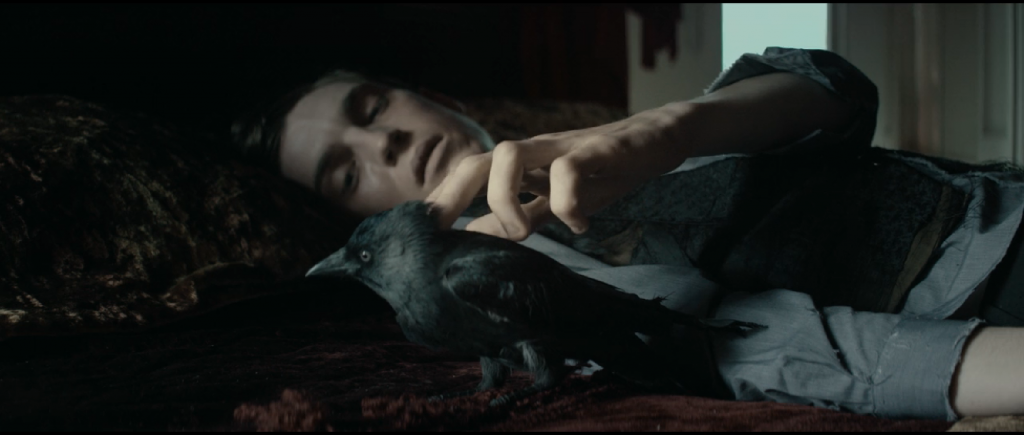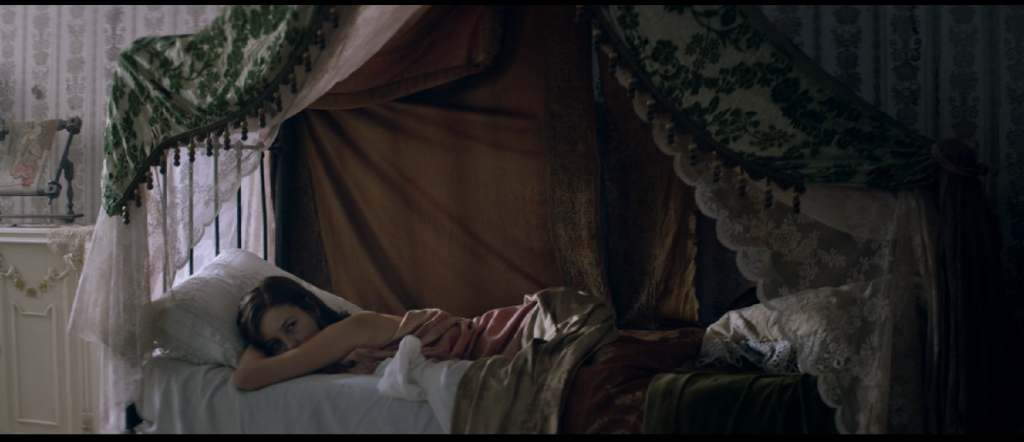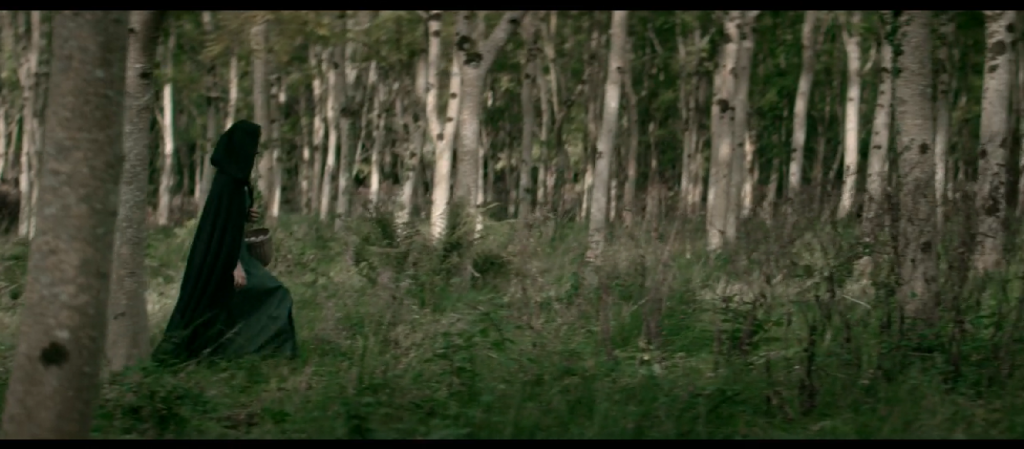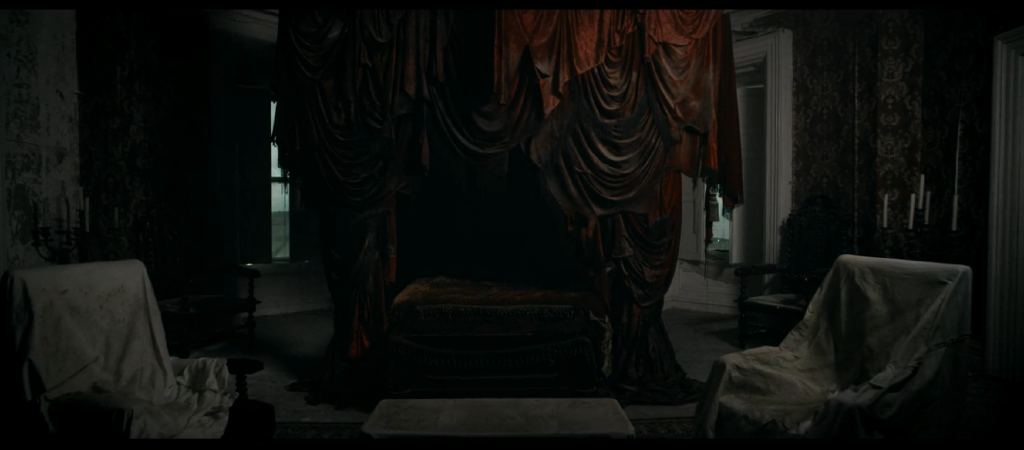
INCEST, the answer is incest.
If you’re marketing anything in the line of gothic horror, it takes a minimum of three words to establish that the big reveal is incest: “twins” and “no outsiders.”

2017 Irish horror film The Lodgers is lusciously beautiful, slightly underbaked, and very much undercut in the suspense department if you happen to take the above deductive shortcut. The Gothic is one of the preeminent genres where obviousness doesn’t necessarily undercut efficacy – in fact, can easily be an asset, a piece of set dressing that evokes delicious foreboding. The Lodgers, though, suffers from a general sense of unrealized intensity and suspense: lukewarm chemistry among the actors, ghosts that are scary-ish at best, etc. This makes the hand-wringing over what ails those reclusive twins, and all the film’s other emotional stakes, all seem a bit empty or tedious, sometimes comically so.
That said, the film is atmospherically beautiful enough to be enjoyed purely on the basis of looks and sound. On those counts, it has the deeply satisfying sensory and emotional coherence of a fairy-tale pocket universe – the psychogeographic trinity of the haunted mansion, the deep woods, and the huddled village. I’ve also mentioned before my affinity for water-based imagery, and The Lodgers overfloweth with mists, depths, drowning phantoms, and surreal, gravity-defying drips.

Anglo-Irish twins Rachel and and Edward live in a decaying country mansion, governed by a set of nursery-rhyme rules (be in bed by midnight; no outsiders), surrounded by phantoms, and feared/scorned by the nearby villagers. The film opens on their 18th birthday, the brink of rupture: Edward is both traumatized by and deeply loyal to the legacy of their house and its rules, while Rachel is restless, defiant, and drawn to a young villager, Sean, who has recently returned from World War I.
I’d argue that Rachel’s and Sean’s romance – while, again, only marginally convincing in terms of chemistry – is the most interesting, fresh, and troubling narrative point in the entire movie, though its potential isn’t fully explored. Rachel’s and Sean’s respective traumas embody the collision of the old-bad and the new-bad: the narcissistically self-destructive aristocracy vs. the mass slaughter and dehumanization of the first World War. Sean argues that the outside world, which Rachel longs for, is full of true hatred: “If you’d seen the world I have, you’d know you were safer here.” Rachel, speaking directly for the Gothic, shoots back that “Love can be worse than hatred.” This comes off as both appallingly presumptuous (one has to assume that both the twins are more or less ignorant of anything happening outside of their estate) and immensely convincing. Hatred is hatred, and can be named as such, but how can one reckon with a love that is hateful? Is the perverted the most deeply monstrous?

Thinking about the movie afterwards, I had to do a bit of digging to remember what felt so familiar about that collision of worlds, and eventually hit upon Angela Carter’s vampire short story “The Lady of the House of Love” (click to read for free online, hosted by the Short Story Project), which is in many respects the mirror image of The Lodgers. In it, a young WWI British officer about to depart for France spends his last days of freedom bicycling through Romania, and encounters a tragic, cloistered vampiress: “With her stark white face, her lovely death’s head surrounded by long dark hair that fell down as straight as if it were soaking wet, she looked like a shipwrecked bride.” He survives, only to be delivered into the jaws of the ultimate monster: the war.
It’s tempting to hold this up as a more morally compelling stance than The Lodgers‘, but that’s in large part because Carter’s story is, of course, a better work of art. The Lodgers flirts with interesting ideas, but doesn’t bring any of them to maturity. In the The Lodgers, Rachel is the survivor, emerging from decay and obsolescence into the sun of a new century: the newly liberated woman, ready, one presumes, to enjoy the social mobility that came in the wake of the war’s disruption. I vaguely appreciated this optimism and celebration of female independence at the same time that they felt completely unearned; there was no compelling reason according to the story’s mythology that she should get to enjoy this outcome, other than “I’m the protagonist.”
I exited the film feeling both seduced and disappointed; it felt like just the outline of a really good Gothic fairy tale. Still, I salute its loveliness, from natural settings to set dressings, and Charlotte Vega’s performance as Rachel, which mixes vulnerability and longing with aristocratic hauteur and a core of steely self-assurance.
Related viewing/reading:
Crimson Peak (2015) (unreviewed, but an obvious comparison point)
I Am the Pretty Thing that Lives in the House (2016)
We Have Always Lived in the Castle (1962), by Shirley Jackson
Ohhh what a tease– a tease of a film, then a tease of a review. Such beautiful haunting screenshots and story, I’m itching to start watching it *right now*